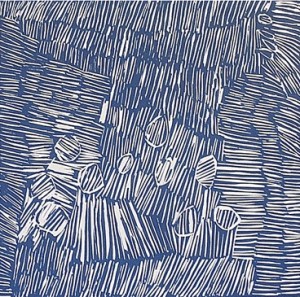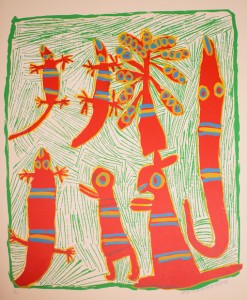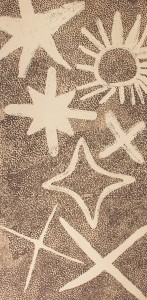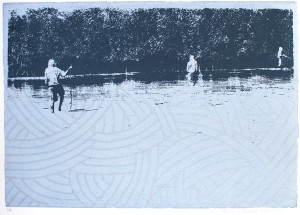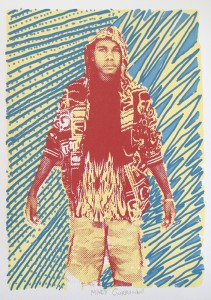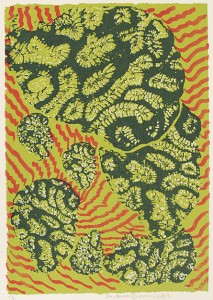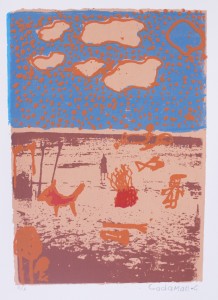When Wandjuk Marika became the first Aboriginal artist to publicly raise the issue of copyright infringement, much more was at stake that one might have initially thought. In 1974, when travelling in his capacity as inaugural chairman of the Aboriginal Arts Board, Marika had been dismayed to discover his sacred clan designs adorning cheap cotton tea-towels ‘published’ in Holland and on sale at tourist shops in Sydney. In his own words (as told to Jennifer Isaacs): ‘when I walked into that shop, and when I saw it [the design] I was shocked. My heart broke’.
By approaching the Australian government to investigate this unauthorized usage, Marika inaugurated a process that eventually, in 1985, would result in the first legal recognition of Indigenous ‘copyright’. As Fred Myers has noted, ‘Wandjuk objected not simply to commodification as a form of desacralisation, but more specifically to the display and use of designs by those lacking ritual authority to do so’. Far beyond what the word ‘design’ might denote in a Western sense, Marika’s clan designs can be visualised as an extension of his very identity, a kind of legal document that sites him within complex cultural, social and geographic networks. ‘Copyright infringement’ then, as a specific Western term, is far from adequate. Perhaps ‘identity theft’ might be more fitting. Within a Yolngu world-view the unauthorized circulation of such designs might have far-reaching and unexpected consequences; synonymous with the power of the country and ancestral narratives they depict, it follows that they too are powerful. To move into the world they need the ‘authorization’ of the artist’s hand.
In 1996, when faced with the decision to support the development of a printing workshop at their art centre, Buku-Larrnggay Mulka in Yirrkala, Eastern Arnhem Land, Yolngu leaders found themselves confronting a similar issue. Would the reproducibility of prints lead to similar misappropriation? Ceremonial leader Garrawin Gumana provided guidance for future Yolngu printmakers and their collaborators by way of a succinct satement, ‘if you’re going to paint the land, you use the land’. That is, in painting or carving the ancestral narratives and designs which usually underwrite Yolngu art, artists must use the very elements of the country they depict: ochre, bark, kapok wood and other materials which are essentially extensions of the land they come to represent. Printmaking, as a technology of reproduction utilizing foreign, industrially produced materials, would have to be directed towards different concerns, that is, beyond country. Here more than anywhere else in Yolngu art the dictates of the sacred would give way to the possibilities of the secular.
Works illustrated here include a recent linocut by Nyapanyapa Yunupingu, whose work has traced a trajectory from personal, non-sacred figuration to mayilimiriw (meaningless) mark-making. Currently celebrated for her bark paintings and recent collaborative work, Yunupingu’s practice began in the print room where she realised her earliest works as colourful screenprints.
Also illustrated are outcomes of workshops undertaken with young Yolngu community members, beginning with photographs taken on their mobile phones. Here the collaborative potential of printmaking in such a context becomes readily apparent. Although relatively humble in form and vision, these works display an important move away from a period style of Yolngu art, a shift occurring at the periphery of the art market’s focus (which remains on original works by ‘star’ artists), yet firmly rooted in the lived reality of day-to-day life. As Nicolas Rothwell has written in relation to this body of work, the task of these young artists is ‘not just to keep alive the traditional designs, and make pleasing art based on them, but to transform a tiny minority society into a strong enclave, operating on an equal footing within the wider nation-state’. For Rothwell, this is a challenge ‘best shouldered by the young, the bicultural and self-confident’. It’s entirely fitting that we see this challenge beginning to be taken up through the medium of printmaking, and placed within a history of robust Yolngu engagement with the ‘outside’ world.
Many thanks to Will Stubbs and Annie Studd for generously discussing the print project during my recent visit to Yirrkala. Yirrkala Printspace enquiries: <prints@yirrkala.com>.
